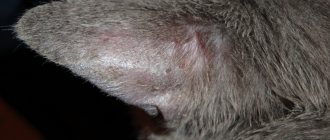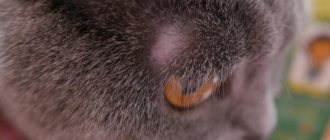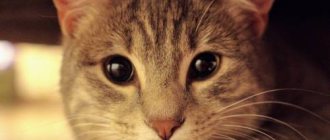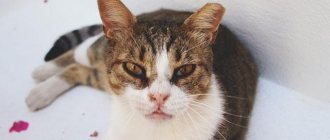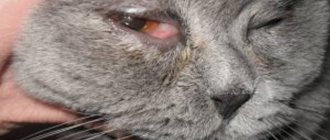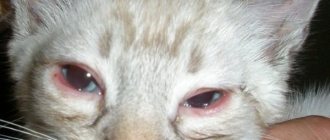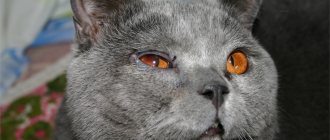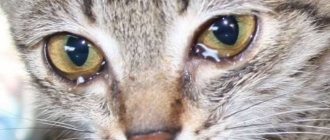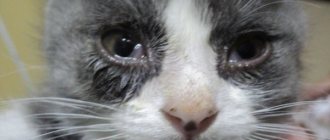A healthy cat's eyes should be clear, clear and shiny. The only acceptable deviation is dried lumps of tear fluid in the inner corners. If a cat’s eyes are watery, and the discharge is abundant and causes visible discomfort to the animal, the pet needs the help of a veterinarian.
Tear production as a variant of the physiological norm
In itself, the release of fluid from the lacrimal canals cannot be considered a pathological phenomenon, since in some cats this process is normal. Basic knowledge about the characteristics of your favorite breed will help the owner understand the reasons why a cat’s eyes are watery.
If the animal has no visible damage to the eyes, there is no swelling, a normal reaction to light remains, and tearing does not cause visible discomfort, the cat is most likely healthy.
Anatomically determined lacrimation
Some cats have tears coming from their eyes due to the structure of their skull or for hereditary reasons.
Persian cats take first place on this list. The Iranian breed is often referred to with the prefix “the most”: long-haired, ancient, domestic. She can also be called “the most whiny” - the Persian cat’s eyes are constantly watering. The animal belongs to the group of brachycephals, in which the width of the head is greater than its length. Due to the small depressed and upturned nose, the cat's tear ducts are deformed, which causes epiphora - constant moisture. This also includes Himalayan cats and exotics.
Scottish Fold and British Shorthair cat breeds are also included in the brachycephalic category. True, their muzzles are not as flat as those of the Persians, so the nasolacrimal ducts are not twisted, but shortened.
The “youngest” representative of this group is the curly-haired Selkirk Rex. Persians, British and exotics took part in the selection of the breed.
Important! For all of these groups, copious secretion of sputum from the canals is a normal and naturally programmed phenomenon. A cat may have tears in only one eye, or one at a time, or both eyes together with varying degrees of intensity. These animals need constant hygienic treatment of watery eyes, otherwise serious problems with hair and skin begin.
Morning tears
If your cat has tears streaming from his eyes in the morning, this is a safe and completely normal occurrence. After sleep, the body is cleansed, clots are removed along with tears, and the cornea is moisturized. Most often, cats wash themselves and clean their eyes. If necessary, the owner can treat untidy crusts in the corners with a cotton swab dipped in a special solution.
Kittens have tears
Tearing in kittens can be caused by several reasons. At an early age, especially before the first vaccination, the baby’s body cannot cope with pathogenic microorganisms on its own. Therefore, discharge from a kitten's eyes may indicate the presence of an infection. Also, causes of excessive lacrimation can be infections with parasites, colds, injuries and allergic reactions.
Tears associated with pathology
There are a large number of reasons for pathological lacrimation.
Allergies to dust, pollen, perfumes, and food products may be accompanied by lacrimation, sneezing and allergic rhinitis in the animal. Sensitive animals especially suffer from perfumes if their owners like to actively use perfumes and deodorants. In this case, lacrimation is observed from both eyes.
In young kittens (2-3 months old), watery eyes may be a sign of weakened immunity. They need outside help to take care of themselves.
Viral infections (calcivirosis, rhinotracheitis) are often accompanied by lacrimation. At the initial stage, the tear fluid may be clear, then it becomes purulent. The general condition of the animal is poor, it suffers from intoxication, high fever, rhinitis and other problems. With viral infections, both eyes become watery.
Bacterial conjunctivitis is accompanied by conjunctival hyperemia, lacrimation, pain and stinging in the eye. The tearing may be bilateral or one eye may be watering.
Eating a large amount of carbohydrate food (sweets, cakes, pastries, bread, cereals) can cause excessive tear secretion. Lacrimation is bilateral.
Anatomical defects, congenital or acquired (injuries, chronic infections that cause narrowing of the lacrimal canal) can lead to unilateral or bilateral flow of tears.
Entropion, or entropion of the eyelids, develops as a result of a genetic defect or a previous illness or injury. In this case, the eyelashes irritate and damage the delicate tissues of the eye and cause hyperemia and lacrimation. There are cat breeds that are prone to entropion (sphynxes, as well as rexes and other similar breeds). The affected eye waters.
Foreign body penetration, chemical (acid, alkaline) and thermal burns cause profuse lacrimation from the injured eye. The conjunctiva is hyperemic and the cornea may be damaged. It hurts the animal to blink and look. The cat squints, the tissue around the eye swells.
There are parasites that choose the eyes of pets as a place to stay. Sometimes they can be seen with the naked eye. Tearing can be quite profuse.
Signs and symptoms of pathological lacrimation
Pathological lacrimation in cats is most often accompanied by the following symptoms:
- the pupil dims or changes color;
- darkened iris;
- injuries to the eye or the area around it: scratches, abrasions, bruises;
- change in the shape of the eyeball;
- inflamed eyelids;
- nasal discharge, the appearance of a purulent substance;
- swelling on the face;
- increased body temperature;
- lack of reaction or delayed response to changes in light flux;
- a cloudy, opaque liquid is released from the eye, which leaves a dirty sticky mark on the animal’s fur.
You can treat a cat at home only after it has been examined by a veterinarian.
Possible reasons why a cat's eyes are watery
If a cat squints and her eyes water, this may indicate the development of serious pathologies in the animal’s body.
Infection: chlamydia
A very striking example of how the disease, even in asymptomatic manifestations, is accompanied by lacrimation from one eye. At the same time, the animal does not show other signs of illness - the appetite is almost not affected, the temperature remains normal or slightly elevated, but copious mucus already signals danger. After 4-5 days, the process affects the second eye, and later affects the respiratory system. During this time, the sick cat manages to infect everyone around.
The infection is spread by rodents; it reaches the mucous membranes along with food or through contact with a carrier. Kittens can become infected from their mother cat during birth.
As treatment, the veterinarian prescribes a course of antibiotics, ointments and drops.
Infection: feline viral rhinotracheitis
The disease is called “feline pneumonia” due to symptoms similar to the human disease. True, this virus is safe for people; only cats suffer from rhinotracheitis. More often than others, young animals and older animals that have problems with immunity suffer.
In addition to the fact that one or both eyes of the cat are watery and red, rhinotracheitis is accompanied by additional signs:
- inflammation of the conjunctiva;
- clouding of the pupil and blurred vision;
- sneezing and excessive saliva;
- lack of appetite and rapid weight loss;
- lethargy, apathy, other signs of malaise;
- slightly elevated temperature that does not reach critical values.
If you consult a doctor in a timely manner, viral rhinotracheitis in a cat can be treated, but in the absence of help, the animal may lose its sight and even die. The death of a cat is most often caused by other chronic diseases that become active in a weakened body. Therefore, as soon as a cat or small kitten’s eye begins to water, the animal should be immediately shown to a veterinarian.
Eye injuries, foreign bodies, burns
A cat's eyes may become watery due to foreign body penetration, mechanical injuries and burns:
- Head injuries can lead to the onset of inflammatory processes in the nasopharynx. In this case, tearing from the cat’s eyes will be one of the first obvious symptoms.
- The ingress of foreign objects also causes a standard reaction - the cat squints and its eyes water. The person’s responsibility is to help the pet get rid of the harmful effects as quickly as possible, before the object in the eye damages the pupil or eyelid.
- Excessive tearing from the eyes of cats can occur due to burns. In this case, the animal will need emergency veterinary care.
Important! In case of injuries or burns to the eyes, the cat needs emergency assistance from a specialist. To avoid serious complications, you should not treat your pet yourself.
Trichiasis and districhiasis
Both signs cannot even be fully called diseases. We are talking about abnormal eyelash growth when the cornea comes into contact with the hairs. This causes permanent eye injury, which is accompanied by tearing. Without timely help from a veterinarian, the cat may develop conjunctivitis or another inflammatory process.
Other reasons why a cat's eyes are watery
Sometimes the cat squints, and later her eyes begin to water, but after a while the symptoms disappear. This indicates periodic irritants that are not signs of any disease, but if you do not pay attention to them, the process can become regular and move into a more dangerous phase.
The reason for the excessive secretion of tears may be new food, for example, when changing the animal’s diet. Most often, the introduction of new products affects the well-being of small cats - their eyes immediately become red and watery.
Bright lighting, heat, wind or cold can be irritants to a cat's eyes.
Caring for cats with eye diseases
A sick cat requires special care to alleviate its condition:
- It is better to cut off the tips of the claws with special tweezers so that the animal does not accidentally touch the eyes;
- dehydration worsens the body’s condition, so if the cat refuses water, you should give it water from a pipette or wet its lips;
- the coat, especially long hair, needs to be combed more often than usual, since it can become matted from lying for a long time; you should not bathe your pet during this period;
- if the cat is prescribed antibiotics, stomach upset may occur, so it is worth starting a course of prebiotic;
- eliminate irritating factors in the room where the animal is located - dust, bright light, other animals;
- During the course of treatment, the cat should not be allowed outside.
When to see a doctor
If, as a result of the injury, the cat's eye is red and watery, you should not postpone a visit to the doctor. The sooner the cat receives help, the greater the chance of preserving the animal’s vision.
Important! If there is dirty or purulent discharge from the eyes, the cat should be taken to the vet immediately!
Diagnostics in the clinic
Diagnostic methods for lacrimation in cats involve a simple visual examination and further laboratory tests. The goal is to identify the cause of discharge from the eyes and prescribe treatment if infectious or other diseases are detected. To clarify the diagnosis, stool analysis, scrapings or smears, and hardware examination of the eyes may be required.
Establishing diagnosis
Before starting treatment, it is imperative to conduct a diagnosis that will help identify the true cause of excessive lacrimation and carry out effective treatment therapy. Only a veterinarian can conduct a correct and thorough examination.
Important! Before going to the veterinarian, be sure to prepare a pet card, which should indicate all vaccinations, anthelmintic treatments, and past illnesses. It is advisable to write down symptoms of malaise and other suspicious signs on a piece of paper.
Sometimes the veterinarian may be interested in the following important questions at the appointment:
- how long the symptoms last;
- how did the first symptoms of tearing from the eyes appear and the peculiarities of the course of this condition, for example, did two eyes immediately begin to water at the same time, or vice versa, first one began, and then the other, and whether there are other additional symptoms;
- when the last procedures to eliminate helminths, fleas, ticks and other parasites were carried out.
To make an accurate diagnosis, the veterinarian will definitely take a urine and stool test. It is advisable to already have the research material with you before going to the doctor. Also, at the appointment, he will definitely take mucus from the eye for examination; for this reason, there is no need to first rinse the pet’s eyes with various solutions.
